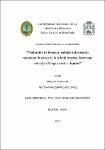Producción de biomasa, calidad nutricional y capacidad de carga de la Alfalfa tropical (Medicago sativa) en Zungarococha - Iquitos
Abstract
El presente ensayo se realizó en las instalaciones del Proyecto de Enseñanza e Investigación Jardín Agrostologico, ubicado en el Km. 5.800 Carretera Iquitos – Nauta, entre el poblado de Zungarococha - Puerto Almendra, Departamento de Loreto, el objetivo fue determinar la producción de biomasa, calidad nutricional y capacidad de carga de la Alfalfa tropical, en condiciones de selva baja, en base a evaluaciones a la 6ta, 8va y 10ma semana, en parcelas de 10 m2, se empleó el diseño de bloques completos al Azar, con tres tratamientos y tres repeticiones, llegando a la conclusión: respeto a la producción de biomasa y materia seca el más alto promedio lo tiene el T3 (evaluación a la 10ma semana, con 3.83 kg/m2 y 833.33 g/m2), la calidad nutricional de los pastos forrajeros se ve influenciado por los tiempos de evaluación, por ello se puede notar que en la Alfalfa tropical una fabácea semiarbustiva el más alto promedio respeto a esta variable lo tiene la evaluación realizada a la 8va semana con valores de (Proteína 18.05%, Fibra 28.82%, Grasa 2.42%, Calcio 60.03mg y Magnesio 150mg); respeto a la capacidad de carga según el promedio de materia verde el T3 (evaluación a la 10ma semana o 70 días) obtuvo un promedio de 16.21 UGA / ha, seguido del T2 (evaluación a la 8va semana o 56 días) con un promedio de 10.47 UGA /ha y en último lugar el T1 (evaluación a la 6ta semana o 42 días) con un promedio de 9.52 UGA/ha respectivamente. The present rehearsal was carried out in the facilities of the Project of Teaching and Investigation Garden Agrostologico, located in the Km. 5.800 highway Iquitos - Nauta, among the town of Zungarococha - Port Almond, Department of Loreto, the objective was to determine the production of biomass, nutritional quality and capacity of load of the tropical Medic, under conditions of low forest, based on evaluations to the 6ta, 8va and 10ma week, in parcels of 10 m2, the design of complete blocks was used at random, with three treatments and three repetitions, reaching the conclusion: I respect to the production of biomass and dry matter the highest average he/she has it the T3 (evaluation to the 10ma week, with 3.83 kg/m2 and 833.33 g/m2), the nutritional quality of the grasses forrajeros is influenced by the times of evaluation, for it one can notice that in the tropical Medic a fabácea semiarbustiva the highest average respect to this variable has it the evaluation carried out to the 8va week with values of (Protein 18.05%, Fiber 28.82%, Fat 2.42%, Calcium 60.03mg and Magnesium 150mg); I respect to the load capacity according to the average of green matter the T3 (evaluation to the 10ma week or 70 days) he/she obtained an average of 16.21 UGA / there is, followed by the T2 (evaluation to the 8va week or 56 days) with an average of 10.47 UGA /ha and in last place the T1 (evaluation to the 6ta week or 42 days) with an average of 9.52 UGA/ha respectively.
Collections
- Tesis [665]
The following license files are associated with this item:


